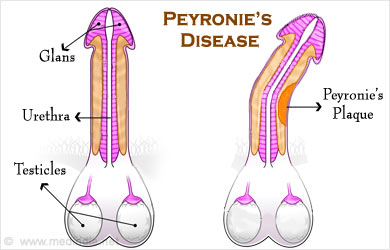If you’ve been diagnosed with Peyronie’s disease, you may be feeling a range of emotions, from confusion and frustration to fear and anxiety.
This condition can be difficult to deal with, both physically and emotionally. But by learning about the causes and treatment options for Peyronie’s disease, you can take steps to properly manage your condition and improve your quality of life.
In this article, we will discuss the causes, symptoms, and possible treatment options for Peyronie’s disease to assist you in making more sound decisions about your care.
So, without further ado, let’s begin!
Table of Contents
What is Peyronie’s Disease?
Peyronie’s disease is one of the most common penile disorders. It is a condition in which the penis curves abnormally. The curvature is usually caused by a buildup of plaque, a type of scar tissue, in the penis.
Peyronie’s disease may cause pain and difficulty with erections. It can also make sexual intercourse difficult or impossible. Peyronie’s disease occurs more commonly in men over the age of 40.
The Main Causes of Peyronie’s Disease
There’s no exact answer as to what causes Peyronie’s disease. However, there are several theories as to potential causes.
Some experts think that the disease is caused by an injury to the penis. This could be from blunt force trauma, such as being hit by a baseball, or from a more penetrating injury, such as a car accident.
Other experts believe that Peyronie’s disease is caused by an autoimmune reaction, where the body’s immune system attacks healthy tissue. According to this theory, men with other autoimmune conditions, such as lupus or rheumatoid arthritis, are more likely to develop Peyronie’s disease.
And finally, some experts believe that Peyronie’s disease is caused by a genetic predisposition. According to this theory, the condition seems to run in families.
No matter what the cause of Peyronie’s disease is, the end result is the same: the formation of scar tissue, or plaque, inside the penis. This plaque builds up and causes the penis to curve or bend.
What are the Symptoms of Peyronie’s Disease?
Just like any other medical condition, Peyronie’s disease has a range of symptoms that can vary in severity from person to person. Here are five of the most well-known symptoms of Peyronie’s disease:
-
A Lump or Bump on the penis
One of the most prevalent symptoms of Peyronie’s disease is the development of a lump or bump on the penis. This lump is usually located on the top or bottom of the shaft, and it may be painful to touch.
-
Curvature of the penis
Another common symptom of Peyronie’s disease is a curvature of the penis. In some cases, the penis may bend to the side. In other cases, it may curve upwards or downwards. This curvature can make sexual intercourse difficult or even impossible.
-
Pain
Many men with Peyronie’s disease experience pain, especially when the penis is erect. This pain may range from a dull ache to sharp, debilitating pain. In some cases, the pain may be severe enough to affect sexual function.
-
Shortening of the penis
Another common symptom of Peyronie’s disease is a shortened penis. This happens when the plaque that has developed in the tissue causes the penis to curve. As a result, the penis may be shorter than it was before the onset of Peyronie’s disease.
-
Erectile dysfunction
ED is a common symptom of Peyronie’s disease. This is because the plaque that forms in the penis may block blood flow to the penis, making it hard to achieve or maintain an erection.
Treating ED issues in men with Peyronie’s disease can be difficult, but there are options available. Just be sure to consult with your doctor about the best course of treatment for you.
What are the Main Treatment Options for Peyronie’s Disease?
Peyronies disease is a common but underdiagnosed condition that can cause pain and deformity of the penis. While there is no cure for Peyronie’s disease, there are a number of treatment options available that can help to improve the symptoms and reduce the severity of the condition.
The most common treatments for Peyronie’s disease include:
-
Surgery
In some cases, surgery might be necessary to correct the deformity caused by Peyronie’s disease. This is generally only recommended in severe cases where the curvature of the penis is causing pain or difficulty with sexual intercourse.
-
Medication
There are numerous oral medications that can be used to help reduce the inflammation and pain associated with Peyronie’s disease. These include nonsteroidal anti-inflammatory drugs (NSAIDs), steroids, and collagenase inhibitors.
-
Physical therapy
Physical therapy can help to improve the range of motion and flexibility in the affected area. This can be beneficial in reducing pain and improving sexual function.
-
Penile traction device
A penile traction device is a device that is worn on the penis to help straighten the curvature. This can be used in conjunction with other treatments or as a standalone treatment.
-
Intralesional injection therapy
In some cases, injections of medications such as steroids or collagenase may be recommended. This treatment can help to reduce the inflammation and pain associated with Peyronie’s disease.
Making lifestyle changes may also help to improve the symptoms of Peyronie’s disease. These changes may include:
-
Quitting smoking
Smoking may cause damage to the blood vessels and contribute to the development of Peyronie’s disease.
-
Eating a healthy diet
A healthy diet may help to improve circulation and reduce inflammation. Try to eat plenty of fruits, vegetables, and whole grains.
-
Managing stress
Stress may worsen the symptoms of Peyronie’s disease. This is because it can lead to tense muscles, which can then put pressure on the penis and cause further damage.
-
Exercising
Exercise may help to improve circulation and reduce stress. It is important to avoid strenuous exercise, however, as this can put additional pressure on the penis and make the symptoms worse.
-
Wearing loose-fitting clothing
Tight clothing can compress the penis and worsen the symptoms of Peyronie’s disease. Wearing loose-fitting clothing may help to reduce this pressure.
If you are experiencing any symptoms of Peyronie’s disease, it is important to see your doctor. He/she will be able to make an accurate diagnosis and start appropriate treatment.
Live a Healthy and Happy Life
Although the cause of Peyronie’s disease is unknown, there are treatments available to help lessen the symptoms.
In case you’re experiencing any of the symptoms associated with Peyronie’s disease, it is important to see a doctor right away. Early diagnosis and treatment may often lead to a quicker resolution of the condition.
So, don’t suffer in silence, be sure to talk to your doctor about any concerns you may have. With proper treatment, most men with Peyronie’s disease can still enjoy a healthy sex life!



















